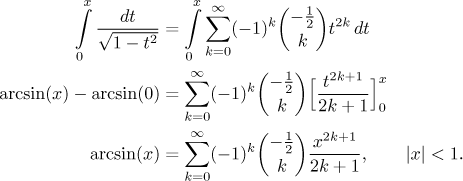Problem: Expand the given function in a power (Taylor) series with the given center:
![]()
Solution: The arcsine is not a function whose series we would remember. Thus we need to find come connection between this function and the quartet that we do remember. There is no way to get arcsine using some algebraic operations from the four functions. One possibility is to use the Lagrange inverse formula applied to arcsine as the inverse function to sine. However, here it is really bad (see below), so we will leave this as the last resort.
We can also try other means of linking functions, for instance differential
calculus. Integral of
![]()
In the form of fraction it resembles the formula for the sum of geometric
series, but the extra square root is an insurmountable obstacle. The second
expression, with negative power, is more promising, since it fits the
pattern for the binomial expansion (which not too many people remember; it
is definitely less popular than the basic four functions, but here we have no
other choice). The last expression is ready for it. Note that this expansion
is valid for

To get to arcsine we need to integrate. There are two possibilities. One is to integrate using a definite integral with variable as the upper limit (then it is good to change the variable in our expansion to t), which yields

The other alternative is to use indefinite integral.

We need to determine C, but that is quite simple. The above equality
is supposed to be true for all x with
The series looks quite nice, but many people would ask about those combinatorial numbers and they would be right. Thus is it worthwhile to try and find a more friendly version.

(Recall the double factorial, see Functions - Theory - Elementary functions.) This looks quite nice, so the answer can be stated as

Remark: How would it go using the Lagrange inversion formula? In our case it goes

The derivative of general order

This seems to fit our result above but to go any further is a waste of time, already the second derivative was quite ugly.